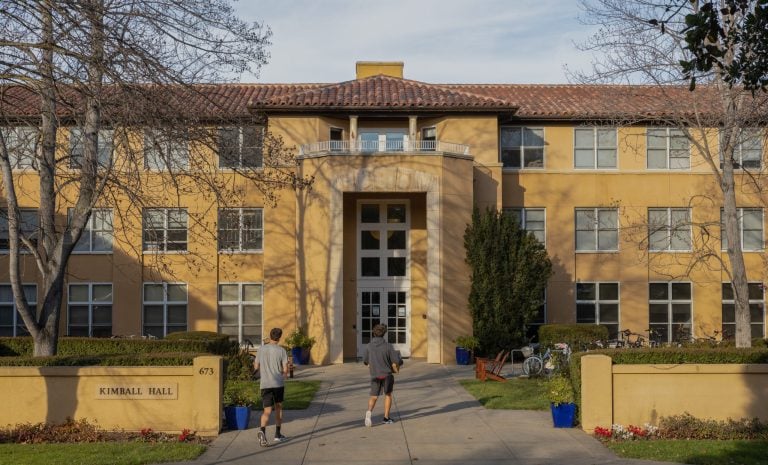At the beginning of fall quarter, Zoe Barley ’23, a transfer student, found a strong sense of community within her transfer cohort as the members collectively navigated life at a new school as non-frosh. Living in Kimball Hall, where most of this year’s transfer students under the age of 25 live, has helped Barley continue to cultivate close friendships with her fellow transfer students.
But as the school year picked up, some transfer students, including Barley, said that they struggled to find friends outside of the transfer community amid what they described as Stanford’s highly competitive classes and clubs scene.
“It’s different from how frosh come in, because frosh, I think, are oftentimes looking for more friends,” Barley said. “And, as a frosh, it’s kind of known that no one has their friend group, whereas when you’re coming in as a junior or a sophomore, friend groups have kind of already been established.”
Barley said that she finds the transfer community to be quite insular.
“If you have a couple of good transfer friends, it’s really easy to just stick with those transfer friends,” she said, adding that it has been difficult for her to connect with her peers through classes. “I do think that being a transfer, you are taking a few classes, oftentimes that are majority frosh, which is a little uncomfortable. I think there’s a level of maturity that happens after a couple years of college.”
Christian Sanchez ’24, a 35-year-old transfer, agreed with Barley and said that he finds it more difficult to connect with 18- to 20-year-olds, as compared to people who are more mature and have life experiences similar to his.
Because the transfer community is spread across Kimball Hall, graduate student housing and family housing, Sanchez, who lives in family housing, has found finding a community both within and outside the transfer cohort difficult. Sanchez said that he often finds it frustrating and awkward to always have to explain to people that he is an undergraduate student. He added that he feels slightly disconnected when talking with other graduate students in family housing. “We don’t have the same level of experience,” he said. “It just kind of builds that whole idea of, you know, why are [we] here? Why are [we] so old?”
Sanchez also feels that the school administration does little to highlight the transfer community and provide a community space for transfers. He cited New Student Orientation (NSO), during which many speakers did not include transfers in their welcome speeches.
Sophomore transfer Diego Liebman ’24 agreed that Stanford could do more to increase visibility of transfers on campus. Liebman said that he appreciated the fact that a transfer student spoke at the annual Faces event during this year’s NSO because it helped shed light on the transfer experience.
Sanchez is now working to increase transfer representation in the Associated Students of Stanford University (ASSU) and has been appointed by the ASSU as a special projects executive fellow to create more awareness of the transfer community on campus. He is also working on trying to find a “homebase” on campus where transfers can attend events and build community. Sanchez feels that transfers are not explicitly included in a lot of class-specific events and opportunities, like those advertised for the “Class of 2024” or “Class of 2025.” He added that this is especially true of frosh events, many of which are intended to help first-year students adjust to college — but as Sanchez pointed out, transfer students are first-years, too.
Liebman said that he has met a lot of non-transfer students by joining clubs, sitting with strangers in the dining hall and attending speaker events where he knows he’ll meet people with similar interests.
If the administration wanted to make transfers feel less isolated, Liebman suggested that the University give new transfers more flexibility in deciding where they want to live. If transfers could opt out of living in Kimball, they would have more agency over their Stanford experience and still remain a part of the transfer community regardless of their living location, Liebman said.
According to Pat Harris, the Senior Director of Communications for Student Affairs, Stanford assigns transfers under the age of 25 to Kimball in order to give them a “built in network of support.” Kimball is also near graduate student residences, where transfer students over 25 live, allowing both age cohorts of transfer students to live near each other.
Liebman said he hopes that the rest of the Stanford community will engage with the transfer community in a meaningful way.
“If someone’s coming from community college, that doesn’t mean they’re not just as smart and driven as you,” he said. “Instead of looking at someone who’s a non-traditional student, if they’re older or whatever it may be, instead of looking at someone as weird, you should look at someone as cool because they probably have a lot of experiences and values that the average student doesn’t have.”
Sanchez, too, emphasized the unique experiences and backgrounds of those in the transfer community. “We definitely offer a unique perspective and different experiences and all come from diverse backgrounds,” he said. “And I think that should be something to be highlighted and appreciated.”
Many transfers said that they remain incredibly appreciative of the opportunity to be a part of a community as unique as that of Stanford’s transfers.
“I’m very grateful for this community,” Barley said, “because I think everyone in it has a really cool story, and is coming from a really cool place and has a lot of maturity and insight and wisdom that other spaces on campus might not necessarily have.”
